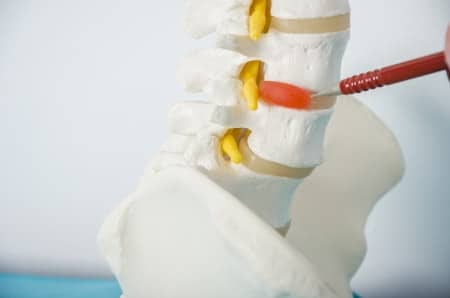Sleeping with a hernia
People with a hernia may find it difficult to get comfortable in bed. What is the best way to sleep with a hernia? This depends on where the hernia is located. It may be a hernia in the lower back, a hernia in the centre or upper back or neck. The direction in which the hernia protrudes also plays a part.
What is a hernia?
An intervertebral disc is a disc-shaped disc and connects two vertebrae. It prevents the vertebrae from knocking against each other and ensures that they can move easily across from each other. The intervertebral disc consists of an outer edge of cartilage and contains a soft, jelly-like core. The core ensures the resilience and the shock-absorbent effect of the vertebrae when moving.
In the event of a hernia there is a tear in the outer band of the intervertebral disc. This causes the jelly-like core to protrude and irritate or even partially trap the spinal cord or the spinal cord nerve. In most cases, a hernia is located in the lower three segments of the spine or at the height of the sacrum. But hernias also occur regularly at the height of the neck.

Sleeping with a hernia in the lower, middle or upper back
To sleep with a hernia in the lower back, an ergonomically correct position of the spine is important so that the pressure on the intervertebral discs – and therefore also the affected intervertebral disc – is evenly divided. This tip also applies to sleeping with a hernia in the middle and upper back. The dynamic ACTIVE+ bed base by Dorsoo supports the lower back upward so that sagging is avoided and the hernia does not deteriorate.
Sometimes, lying on the opposite side of the protruding hernia is less painful. It may be that, over time, the hernia retracts due to gravity and correct division of pressure, and the nerve experiences less pressure and irritation. This will reduce or eliminate the pain and possible tingling in the run of the nerve.
If you sleep better on the side where the intervertebral disc protrudes, you can position the legs slightly higher, possibly with an adjustable bed base to unload the hernia on the side of the protrusion.
If the hernia protrudes left or right, it may be more comfortable to sleep on your back. People with a hernia protruding backwards, normally lie better on their side.
Sleeping with a neck hernia
An ergonomic pillow that can be height adjusted may be beneficial for sleeping with a neck hernia. The freedom of movement (rotation, flexion, extension) of the neck is much greater so that it is more difficult to control a good position. Theoretically speaking, it is better to lie on the other side of the protrusion when you have a neck hernia.



